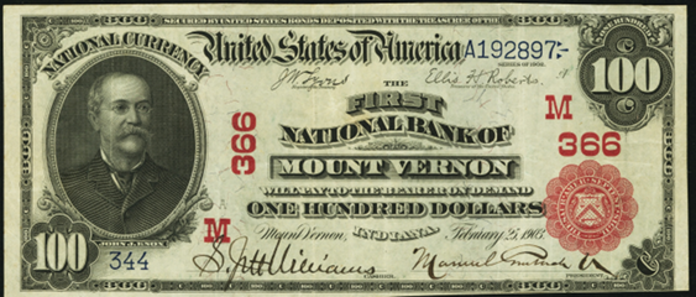One Hundred Dollar Notes › Nationals › 1902 One Hundred Dollar National Bank Notes › Pennsylvania Charters › 1902 $100 Scranton Pennsylvania Traders National Bank
Get Value Now
| Item | Info |
|---|---|
| Series | 1902 |
| Charter | #4183 Traders' National Bank of Scranton, Pennsylvania |
| Year Chartered | 1889, 236 Banks Chartered |
| City Info | Scranton is the sixth-largest city in the Commonwealth of Pennsylvania behind Philadelphia, Pittsburgh, Allentown, Erie and Reading. It is the county seat of Lackawanna County in Northeastern Pennsylvania's Wyoming Valley and hosts a federal court building. With a population of 77,291, it is the largest city in the Scranton–Wilkes-Barre–Hazleton, PA Metropolitan Statistical Area, which has a population of about 570,000. Source: Wikipedia |
| Similar Cities | If your note doesn't match try: 1. Scranton, Pennsylvania - Second National Bank 2. Scranton, Pennsylvania - First National Bank 3. Scranton, Pennsylvania - Third National Bank 4. Scranton, Pennsylvania - First National Bank 5. Scranton, Pennsylvania - People's National Bank 6. Scranton, Pennsylvania - Union National Bank 7. Scranton, North Dakota - First National Bank 8. Scranton, Pennsylvania - County National Bank 9. Scranton, Pennsylvania - Hyde Park National Bank |
| Seal Varieties | Red, Blue |
| Other Info | 1. Value depends on notes known for charter, condition and market demand. |
| Neat Fact | 1-5 Digit Charter number critical to note identification. It is Red, Blue, Black or rarely absent altogehter. It is printed over the note design. |
No Obligations Offers and Appraisals
Please submit a good photo or scan. It will be identified and evaluated. Understand there may be subtle differences between the image you see above and your note. Signatures, design, markings and note condition will determine the offer price. Notes in Uncirculated or better condition receive the best offers.
Appraisals can be estimated for wholesale and retail prices. Wholesale is what dealers typically pay. Retail is what a collector might pay. Retail is slightly higher in most cases.
Please visit this page for USA Paper Money Reference. Do not treat this page as a reference guide, it is for appraisal and acquisition purposes only.
